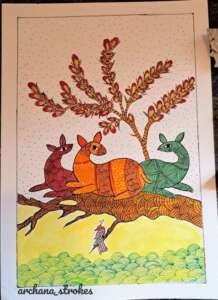*Gond Art: A Vibrant Expression of Tribal Culture*
Gond art, a traditional Indian folk art form, originates from the Gond tribe of central India, particularly in Madhya Pradesh and Chhattisgarh. This vibrant art form has been a vital part of Gond culture, reflecting their mythology, folklore, and everyday life. Characterized by geometric shapes, natural colors, and intricate patterns, Gond art has gained recognition globally for its unique aesthetic appeal.
*Origins and Significance*
The Gond tribe, one of India's largest indigenous communities, has a rich cultural heritage. Their art form, passed down through generations, serves as a means of storytelling, preserving traditions and myths. Gond art often depicts nature, animals, and tribal deities, showcasing the community's deep connection with the environment.
Gond art is distinguished by:
- *Geometric shapes*: Circles, squares, and triangles create intricate patterns.
- *Natural colors*: Earthy tones, blues, and greens dominate.
- *Dot painting*: Small dots form designs and textures.
- *Line work*: Bold lines define shapes and figures.
Traditional Gond artists employ:
- *Natural materials*: Bamboo, cotton, and paper.
- *Hand-painted*: Natural dyes on paper or canvas.
- *Dot painting*: Fingertips create dots.
Gond art has Influenced modern Indian art, Contributing to the Indian art movement It has inspired global artists Influencing designers, architects, and artists worldwide. This tribal art has received national recognition Padma Shri awards for Gond artists. It is also recognized by UNESCO as Intangible Cultural Heritage
Gond art is a vibrant expression of tribal culture, reflecting the community's rich heritage and connection with nature. Its unique characteristics, significance, and contributions have earned global recognition. Preserving and promoting Gond art ensures the continuation of this valuable cultural legacy.

